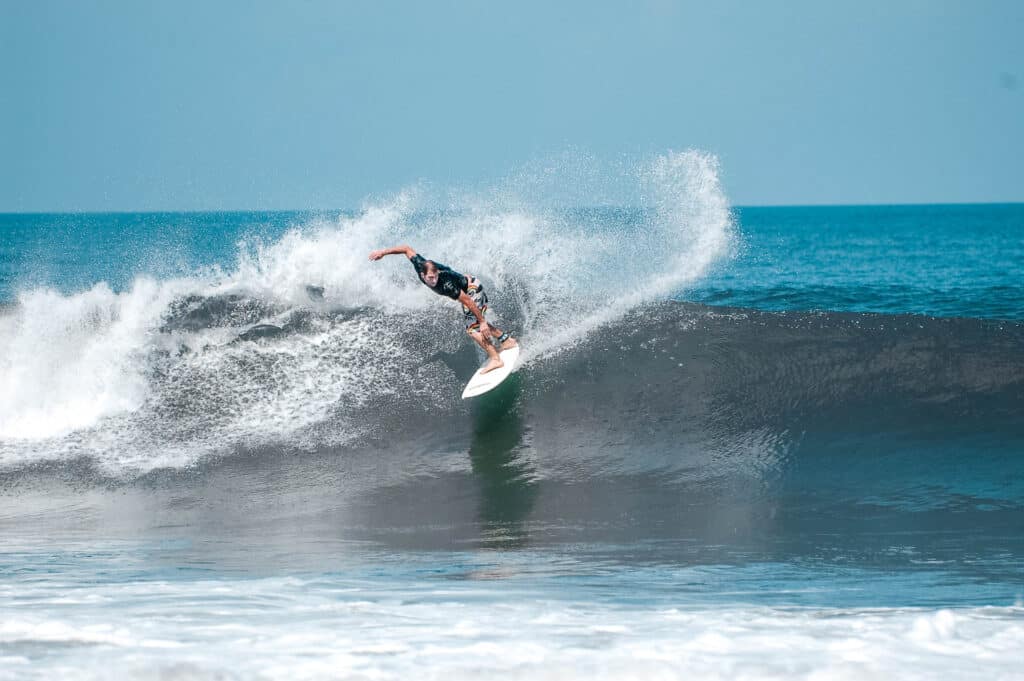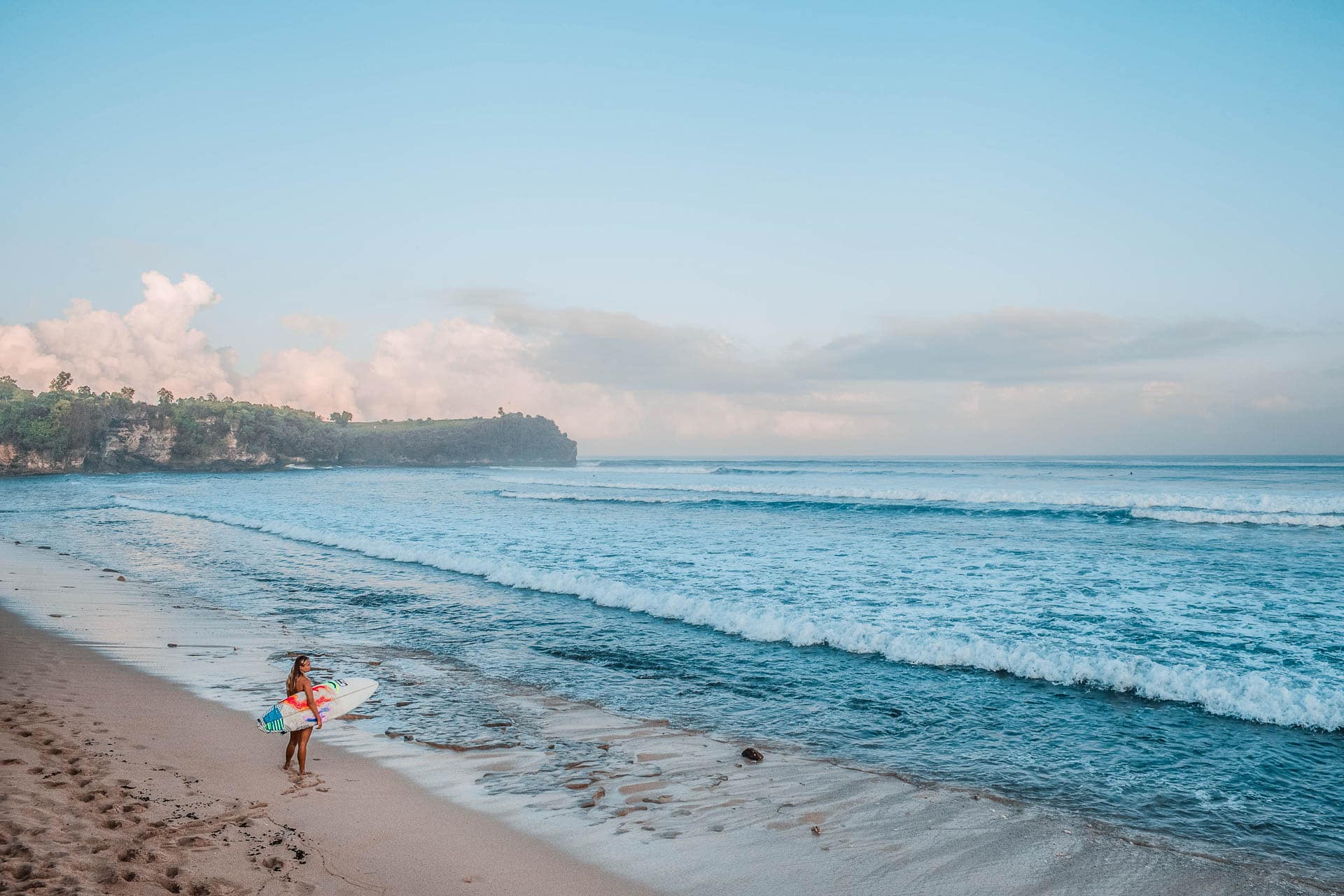Wave reading is a crucial skill for surfers, as it allows them to anticipate and ride waves effectively while also ensuring their safety in the water. To read a wave, it’s important to identify its key elements, such as the peak, face, and trough. The peak is the highest point of the wave, while the face is the sloping, unbroken part, and the trough is the lowest point. By observing these parts and all the other factors, surfers can anticipate the direction and size of the wave, which is essential for catching it at the right moment.
Understanding wave patterns is also vital. Surfers should look for potential breaking points where the wave is likely to crest and break, creating the best opportunity to catch and ride it. Observing the behaviour of the waves from the shore before getting in the water is a key safety precaution. By studying how the waves are forming and breaking, surfers can assess the conditions and make informed decisions about when and where to enter the water.
Different Parts Of A Wave
The different parts of a wave impact surfing in various ways:
1. Peak
The peak of a wave is the highest point of the wave, where it begins to break. It is the most powerful part of the wave and is ideal for surfing as it provides the most speed and energy.
2. Shoulder
The shoulder of the wave refers to the sloping, unbroken part of the wave that is adjacent to the peak. Surfers often ride the shoulder of the wave as it provides a smooth and long ride.
3. Bottom Contour
The bottom contour refers to the shape of the ocean floor beneath the wave. It plays a significant role in shaping the wave as it approaches the shore, creating different wave types such as barrels, point breaks, and beach breaks.
Types of Waves
Each type of wave offers its own unique surfing experience, and knowing how to navigate and ride each one can take your surfing to the next level. Whether you prefer the challenge of a powerful closeout or the long, peeling ride of a perfect A-frame, being able to identify and surf different types of waves is key to becoming a well-rounded and skilled surfer.
There are four main types of waves that surfers encounter: rights, lefts, A-frames, and closeouts.
Right-hand Wave
A right-hand wave is a type of wave that breaks to the right when viewed from the surfer’s perspective. It is characterized by a smooth, peeling shape that allows for long rides.
Regular-footed surfers prefer right-hand waves because they can ride frontside, meaning they face the wave as they ride it. This allows for better control and manoeuvrability on the wave. To ride a right-hand wave, surfers need to position themselves slightly to the left of where the wave is breaking, allowing them to drop in and ride the face of the wave as it peels from left to right. Good technique is essential for maintaining speed and performing turns on a right-hand wave.

Left-hand Wave
In surfing, “left” refers to the direction of a wave as it breaks from the surfer’s perspective, meaning it breaks towards the surfer’s left side. This direction is significant because it determines the positioning and movement of the surfer on the wave. Goofy-footed surfers, who have their right foot forward on the surfboard, often prefer left-breaking waves as it allows for smoother and more natural movements while surfing frontside. Left waves are preferred by many surfers for this reason.

A-Frame
The A Frame is a unique wave formation characterized by its peak-shaped wave with both right and left shoulders, providing surfers with the option to go either left or right. This versatility makes it a popular choice for surfers of all skill levels.

Close-out
A closeout wave can be identified by observing the top of the wave to see if it forms a straight line from one end to the other, with no discernible peak or shoulder. This indicates that the wave is breaking all at once, with no clean face for surfing. In contrast, potential surfable opportunities will have distinct peaks and shoulders, indicating the formation of a wave that may provide a clean, open face for surfing.
Pay attention to the angles and slopes of the wave to determine if it will break simultaneously or provide a clean, open face for surfing. A closeout wave will have a steep slope and a straight angle, while a potential surfable wave will have a more gradual slope and a curved angle.
Understanding the formation of the wave is crucial in distinguishing a closeout from a surfable opportunity. By observing the top of the wave and paying attention to the angles and slopes, surfers can make an informed decision about whether a wave is worth riding or not.
Surfers Love Rapture Surfcamps
Understand The Rhythm Of The Tides
The gravitational pull of the moon creates the daily rhythm of the tides. As the Earth rotates, the moon’s gravitational pull causes bulges of water on the side of the Earth facing the moon and on the opposite side, creating high tides. The sun’s gravitational pull also contributes to this effect. As the Earth rotates through these bulges, high and low tides occur in predictable patterns.
These tides affect specific local breaks by determining the volume of water covering the shorelines. During high tides, waves can break closer to the shore, while low tides can expose rocks or sandbars, altering the wave shape and quality.
Swell
The size and period of a swell are crucial factors that impact surfing conditions.
Swell size refers to the height of the waves, while swell period indicates the time interval between each wave. A larger swell size generally produces more powerful waves, providing better surfing conditions. However, if the swell period is too short, the waves may become choppy and unpredictable, making it challenging for surfers to catch and ride the waves effectively.
Swell height is typically measured in feet or meters, with larger measurements indicating more favourable surfing conditions. On the other hand, swell period is measured in seconds, and a longer period suggests more organized, smoother waves that are ideal for surfing. Surfers use this information to assess the quality of the waves and determine the best time to hit the water for an optimal experience.

When checking a surf forecast, it’s essential to pay attention to both the swell size and period to understand the wave conditions better. The top 5 most relevant keywords for this section are swell size, swell period, surf forecast, wave height, and wave duration.
To become a better wave-reader, it is essential to understand the basics of wave reading and how to predict how waves will break. This involves observing the swell direction, wave height, wave period, and the shape of the ocean floor to anticipate how the waves will behave.
The learning process in wave reading can be accelerated through patience, time, and experience. It is important to be patient and spend ample time observing and learning from more experienced surfers. With time and experience, surfers can develop a better understanding of how waves break and how to position themselves on the wave for optimal performance.
Valuable tips for reading waves include paying attention to the wave’s shape and form, as it can provide clues about whether the wave will be a right, a left, or a close-out. Understanding the wind direction and how it affects the waves, as well as recognizing patterns in wave behavior, can also help surfers excel in the sport.
Learn all about surfing with Rapture Surfcamps! Whether you are looking for surf camps in Bali, Portugal or Morocco, we have our camps in all these top locations with all the amenities you need for a perfect surf holiday! With an array of accommodation option to suit every kind of budget, Rapture Surfcamps is a good choice for all levels of surfers.
FAQs
Wave reading refers to the skill of interpreting and understanding ocean waves for various purposes, such as surfing, sailing, or safety at the beach. It involves analyzing wave characteristics to make informed decisions.
Waves consist of a crest (highest point), trough (lowest point), wavelength (distance between crests), and wave height (vertical distance from trough to crest).
To determine wave direction, observe the line of the crests. Waves generally move perpendicular to their crests, so follow the line to understand the direction they are coming from.
Wave period is the time it takes for one complete wave cycle to pass a fixed point. It is crucial because longer periods generally indicate more powerful and potentially larger waves.
Wave height is measured from the trough to the crest. Experienced individuals can estimate this visually, but for a more accurate measurement, use nearby objects like buoys or other surfers as reference points.
Observe the waves as they approach the shore. Breaking points are typically where waves start to crest and break. Knowing these locations is crucial for surfers and swimmers to avoid dangerous conditions.
Rip currents are narrow, fast-moving channels of water flowing from the shore to deeper water. To identify them, look for areas where waves break less consistently or where water appears darker due to the deeper channel.
Yes, several resources provide real-time wave data, including weather websites, surf reports, and mobile apps. Buoys and beach webcams can also offer valuable visual information.


